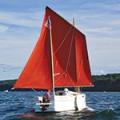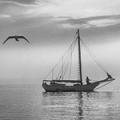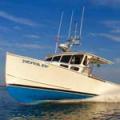Big ships, LEGOs, and a joyful duck
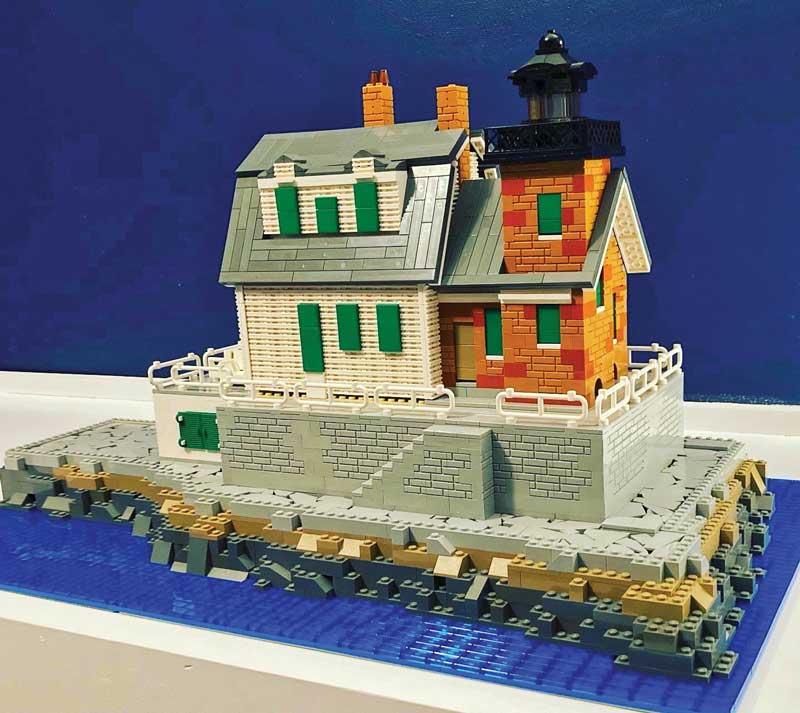 Colby Adolphsen’s first big LEGO project was this replica of the Rockland Breakwater Light. Photo courtesy Colby Adolphsen
Colby Adolphsen’s first big LEGO project was this replica of the Rockland Breakwater Light. Photo courtesy Colby Adolphsen
Lighthouses built out of LEGOs
Forget that store-bought Star Wars LEGO kit, a midcoast Maine creator has been designing and building elaborate, to-scale LEGO models of coastal landmarks, including the Rockland Breakwater Light and the Camden Public Library.
Colby Adolphsen, who works in the quality and control department at Pen Bay Medical Center in Rockport, played with LEGOs as a kid. But he hadn’t built anything for about a decade when the urge hit him to start building again a few years ago. He started with Rockland’s Breakwater Light, which took about a month to create, working mostly at night after his 1- and 4-year-old sons had gone to bed. He followed up with a model of the Marshall Point Light in Port Clyde and then a harbor scene inspired by Camden and Rockport. “I didn’t set out when I first started building stuff to have such a coastal Maine theme,” he explained, “but as I went along I found that was what I enjoyed the most. Building something that was so familiar to me was a lot of fun.”
His most recent replica of the Camden Library is his biggest project so far. That incredibly detailed model took between 80-90 hours over a two-month period to complete. The model even includes interior spaces viewable through tiny windows.
Once he has chosen a project, Adolphsen said he maps out the steps, trying to make sure his measurements are right. He scales his buildings based on the size of a LEGO person. “It’s not an exact science,” he said. “The process for me is a lot of fun and creative, but also analytical.”
Adolphsen doesn’t know how many LEGO pieces have been used in his projects, noting only “it’s in the thousands.” And he has no idea how many LEGOs he owns—he constantly scours the internet for collections to acquire.
And for any parents of LEGO-obsessed children wondering how Adolphsen protects his creations from his kids: “They are pretty good,” he said. “My oldest son has started to build his own things. And sometimes I build kits for him.”
Check out Adolphsen’s other builds on his Instagram @chorangebricks.
 Greater Joy appeared late last fall in Belfast Harbor. Photo by Nicolle Littrell of DoryWoman Rowing
Greater Joy appeared late last fall in Belfast Harbor. Photo by Nicolle Littrell of DoryWoman Rowing
Big duck brings big joy
The mysterious Joy duck that first appeared in Belfast Harbor in August 2021 made an autumn return, reappearing sometime before dawn October 21, according to various news reports. The only difference this time was the duck brought even more joy, literally. A year ago, the giant yellow rubber duck sported the word “JOY” in big letters. This time the message had been expanded and read “GREATER JOY.”
The humongous rubber ducky towered over many of the smaller boats in Belfast Harbor attracting attention from residents and visitors who flocked—no pun intended—to the Belfast footbridge to share in the joy.
“It’s nice to see something like this bringing light in dark times,” said one frequent harbor visitor. But like many good things, the joy was fleeting. The giant rubber fowl did not stay long at her mooring in the harbor. She was seen later in the month flying down Penobscot Bay in one of the big autumn blows, carrying her message to the open water. “Greater Joy fled the nest,” said one onlooker.
According to one rumor, Greater Joy ended up somewhere on Islesboro. But despite several calls to Belfast and Islesboro, no one admitted to knowing who might have created Greater Joy.
Andre the Seal gets a sauna
A little bit of Finnish culture has landed on the waterfront in Rockport. A sleek sauna-on-a-trailer has been heating things up alongside the statue of Andre the Seal in the town’s Marine Park since the fall.
A Lincolnville couple, Josh and Beth Goodman, are offering saunas in the mobile unit as part of their business Native Sauna. Rockport’s Board of Selectmen have given the business a permit to operate in the park until March 31, 2023, while various town committee figure out a policy for dealing with commercial vendors in town parks, according to a report in the online Village Soup.
Beth, a former teacher, and Josh, a native of Australia who has worked as a builder, design, build, and sell backyard saunas. They also rent out their sauna trailer and a mobile, wood-fired hot tub. The idea behind placing the mobile sauna in the park is to introduce people to the concept of Finnish saunas and make the experience available without the expense of owning one, the couple told the online Village Soup news service. The sauna seats three. Seats can be rented for 75-minute sessions or the whole sauna can be rented for that amount of time. The Goodmans told Village Soup they want to introduce locals to the joy of sauna and its benefits—reasons why the practice is so ubiquitous in Finland. But the mobile sauna in harbor park will be different in one key way: bathing suits are not optional.
Bar Harbor votes for fewer cruise ship passengers
Residents in Bar Harbor, traditionally one of Maine’s most popular cruise ship destinations, have voted to restrict the number of passengers disembarking into the town to no more than 1,000 per day.
The citizens initiative, which was supported by 58 percent of the town’s voters, could result in a 95 percent reduction in cruise ship passengers, according to an article in the MDI Islander.
“Lots of people, both on the island or just visitors, they detest the crowds that the cruise ships cause in Bar Harbor, and they won’t come anywhere near our downtown,” resident Charles Sidman, who spearheaded the citizens’ initiative, told the newspaper. The amendment applies to cruise ships that make reservations after March 17.
Since a vast majority of cruise lines partnering with Bar Harbor have a carrying capacity of more than 1,000 passengers, this initiative all but outright bans large ships from stopping in Maine’s largest port, according to the Islander, noting that ships with 1,000 or fewer guests only make up five percent of the yearly ship schedule. The new measure calls for the harbor master to create a reservation system and track daily counts. Cruise lines violating the ordinance could be subject to a $100 fine for every person over the limit.
In 2019, 157 ships carrying a combined 250,164 passengers visited Bar Harbor and the number has increased since then, according to the Islander. Currently, daily limitations allow up to 3,500 passengers in July and August and 5,500 in May, June, September and October.
Portland sees uptick in freighters
Maine’s only freight seaport soon will be getting busier with the Icelandic shipping company Eimskip adding a fourth vessel to its rotation of container ships that dock in Portland, according to an article in the Portland Press Herald.
The 426-foot-long freighter Selfoss will increase Eimskip’s cargo capacity to and from Maine by 25 percent, the newspaper reported. Eimskip currently sails three ships on a transatlantic route, stopping once a week in Portland, where the company has its North American headquarters. The container service began in 2013 with trips every other week, and in 2017 Eimskip increased the number of trips each year to 52. There are stops along the way in Nova Scotia and Newfoundland, according to the Press Herald.
Another shipping business with roots in Iceland, logistics company North Atlantic Cargo Line, and subsidiary Isafold Distribution Center, also is growing rapidly. That company’s CEO, Ólafur Matthíasson, told the newspaper that the NAC Line has recently grown its freight-handling business from 50 to 500 containers a year. Isafold, which started in Wells in 2019, has grown from 35 orders a week to 3,500, he said. The company recently leased a site at The Downs business park in Scarborough, increasing its square footage from 350 square feet to 10,000 square feet.
As of 2021, frozen fish was by far the most imported material by value in Portland, but top imports also included machinery, apparel, beverages, minerals, and metals.
Ammunition cartridges, prepared fruits and vegetables, medical instruments, industrial and electric machinery, and pulp and paperboard were some of the most valuable exports, according to the newspaper.
New training ship for MMA
If all goes as planned, the Maine Maritime Academy in Castine will have a new training ship before the end of 2024. To be christened as the next T/S State of Maine, the new ship is the third of five “national security multi-mission vessels” authorized for construction by Congress. The ships will be owned by the federal Maritime Administration, and stationed at each of the nation’s state maritime academies to serve both as training ships and as emergency response platforms, according to a story in the Island Institute’s Working Waterfront newspaper.
The new ship, which is being built at the Philly Shipyard in Philadelphia, will replace the academy’s current training ship, the State of Maine, which took its first summer cruise for the academy in 1997.
The current State of Maine stretches just a few inches less than 500 feet. The new ship, scheduled to arrive in October 2024, according to the Working Waterfront, will measure 525 feet long, with a beam of about 88 1/2 feet, which is about 17 feet wider than the current State of Maine. The new ship will have accommodations for up to 1,000 personnel including a mix of crew, faculty, students, and emergency responders, when required, more than three times the capacity of the current State of Maine. The ship will also have state-of-the-art hospital facilities, storage for 60 shipping containers, a helicopter landing pad on deck, and roll-on/roll-off vehicle loading capability via ramps in the hull sides.
Salmon released into the Penobscot
With the recent release of 300 mature Atlantic salmon into the upper reaches of the East Branch of the Penobscot River, Maine has taken another step forward in its effort to restore the critically endangered species. The release was a milestone in a three-year project designed to increase the number of Atlantic salmon that spawn in the favorable habitat of the East Branch. “The East Branch of the Penobscot has lots of high-quality habitat for Atlantic salmon, but mortality in both the marine and freshwater environments prevents many from reaching it," said Department of Marine Resources Scientist and project lead Danielle Frechette, Ph.D. “One of the best ways to help Atlantic salmon move toward recovery is to have more adults spawning in this high quality, but largely vacant, habitat.”
Atlantic salmon migrate in the spring from the rivers where they were born to waters off West Greenland where they will spend one or two winters maturing at sea. The adults migrate back to their natal rivers to reproduce in nearly the same spot where they were born.
It is estimated that 100,000 Atlantic salmon once made the annual spawning migration back to the Penobscot River. However, dams, log drives, pollution, and overfishing combined to bring Atlantic salmon to the brink of extinction.
The effort to increase the number of adult salmon in Maine rivers began in 2019 with a partnership among NOAA, DMR, the University of Maine, Cooke Aquaculture USA, the US Fish and Wildlife Service, and the Penobscot Indian Nation. The project is designed to allow salmon to avoid the high mortality at dams and at sea by raising them in captivity to the mature, adult stage. “The ability to rear salmon in salt water while protecting them from the hazards that they would encounter in the wild ensures more spawning adults in the Penobscot than we would otherwise see,” Frechette said.
In 2020, adult salmon that returned to the Penobscot River were collected and taken to the USFWS Craig Brook National Fish Hatchery to spawn. Their offspring were transferred to Green Lake National Fish hatchery where they were raised to the smolt stage.
Biologists will track the released salmon as they make their way out to the ocean.
“Our goal with this project is to take a step toward restoration of this iconic, endangered species, and to explore how this novel approach, which includes the use of aquaculture to bypass the hazards in the freshwater and marine environment, can play a part in the success of this effort,” said Frechette.
Maine-built subway canopy
 One piece of the canopy being transported. Photo courtesy Lyman-Morse
While most people associate the name Lyman-Morse with boatbuilding, the company’s Lyman-Morse Technologies division has taken on projects well beyond the marine environment. A recent project involved building a canopy for the Kendall Square MBTA station in Cambridge, MA. The 160' x 32' canopy structure, made of fiberglass with carbon-fiber bulkheads, was one of the division’s largest architectural projects so far, according to a company write-up.
One piece of the canopy being transported. Photo courtesy Lyman-Morse
While most people associate the name Lyman-Morse with boatbuilding, the company’s Lyman-Morse Technologies division has taken on projects well beyond the marine environment. A recent project involved building a canopy for the Kendall Square MBTA station in Cambridge, MA. The 160' x 32' canopy structure, made of fiberglass with carbon-fiber bulkheads, was one of the division’s largest architectural projects so far, according to a company write-up.
The first part of the project was physically building two separate, symmetrical pieces for the canopy that would then be joined together once on site. That involved building a mold for the 80'′ x 32'′ pieces, which were then laid with fiberglass and infused with resin. Each canopy received a marine-grade coating. In mid-September, the LM crew loaded the two pieces on a barge, which carried them to Boston, and up the Charles River to Cambridge, where they were unloaded and carefully transported through the streets to their final destination in Kendall Square.
Later this fall, programmable lighting will be suspended from the top of the canopy structure, allowing Massachusetts Institute of Technology to change colors and create displays for events.
Hinckley wants you
Hinckley Yachts has established a student loan program with trade schools in the hopes of adding positions to its manufacturing and service sectors in Maine in the coming year. “We are very committed to developing the talents of our existing team members and recruiting new talent to the industry,” said Geoff Berger, CEO of The Hinckley Company, in a news release. “The program will support that, as do all our managers and team leaders on an ongoing basis, by training and teaching our time-honored methods on the job.”
Through the Hinckley Yachts Student Loan Assistance Program, Hinckley will help pay off student loans for graduates of post-secondary school technical trade programs in the region who get jobs with the company—this includes the Landing School in Arundel, which is one of New England’s leading institutions for career development in the marine and yachting space. Hinckley employs about 260 people in its operations in Trenton and Southwest Harbor, Maine, according to the release.
The Landing School offers diplomas in boatbuilding, marine systems, and yacht design, and associate’s degrees in marine industry technology.
The first vessel built by English colonists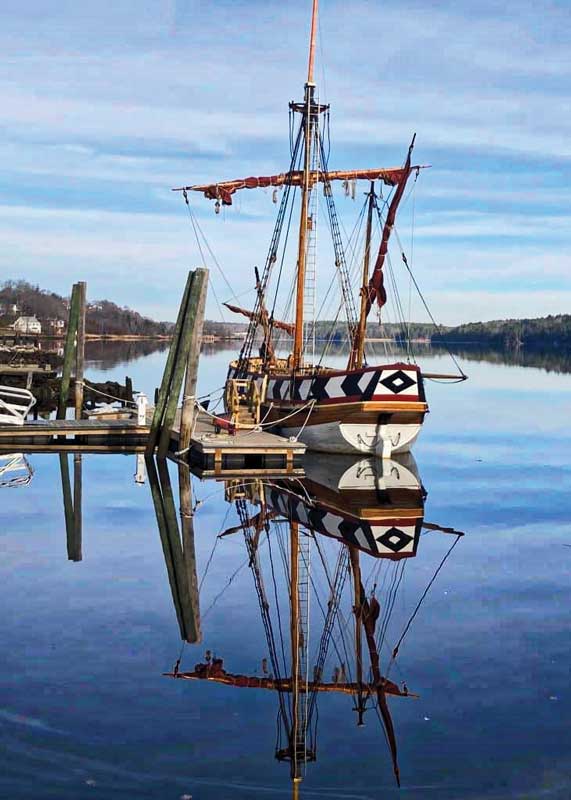 The Virginia at her dock in Bath. Photo courtesy Maine’s First Ship
The Virginia at her dock in Bath. Photo courtesy Maine’s First Ship
After years of work, the Virginia, a reconstruction of the first vessel built by English colonists in the Americas, was finally launched last spring in Bath, where it was moored this fall on the waterfront. The 51-foot vessel is the work of a group of volunteers with the nonprofit Maine’s First Ship. Since its launching, the vessel has been rigged with most of its sails. The engine is in working order and most of the necessary electronic systems are in place. “It’s amazing how much electronics you need to take a 17th century boat to sea in the 21st century,” said Ken Borgendale, a volunteer who maintains the organization’s web site. Modified from a vessel that would have been used in the 17th century for ocean voyages, the Virginia has a beam of 14.5 feet, and will draw about 6 feet when fully loaded. Plans called for the vessel to have a test sail in early December before being moved to the Wiscasset town dock for the winter. When the Kennebec is ice-free in the spring, the Virginia will return to Bath, Borgendale said.
Maine boats racing around the world
Late last June, a fleet of Class 40 sailboats set off from Tangiers, Morocco, to begin a voyage that would take them around the world over the next nine months. Of the six boats that gathered for the start, three have deep roots in Maine.
Brian Harris, the general manager at Portland’s Maine Yacht Center, is a co-skipper with Brunswick native Micah Davis in the doublehanded race. Their boat, Amhas, was one of two Class 40s that arrived in 2013 as an incomplete kit and was fitted out at MYC. The other is Whiskey Jack (ex-Toothface), sailed by Canadian Mélody Schaffer. A third boat, Gryphon Solo II, took singlehanded sailor Joe Harris nonstop around the world in 2015—with two major Maine Yacht Center refits before that voyage and this Globe 40 event. GS2’s co-skipper is Portland resident Roger Junet.
From Tangiers, the Globe 40 takes its competitors around with world with eight stops along the way: Cape Verde Islands (Atlantic Ocean); Mauritius (Indian Ocean); Auckland, New Zealand; Tahiti; Ushuaia, Argentina; Recife, Brazil; Grenada (Caribbean Sea); and Lorient, France. The competitors should round Cape Horn in late December and finish the race in late March.
You can follow the race and cheer for your favorite Maine crew at the Globe 40 website: www.globe40.com/en/map-tracker —By Tim Murphy
Related Articles
Share this article:
2023 Maine Boat & Home Show

Join Us for the Maine Boat & Home Show!
Art, Artisans, Food, Fun & Boats, Boats, Boats
August 11 - 13, 2023 | On the waterfront, Rockland, Maine
Click here to pre-order your tickets.
Show is produced by Maine Boats, Homes & Harbors magazine.








